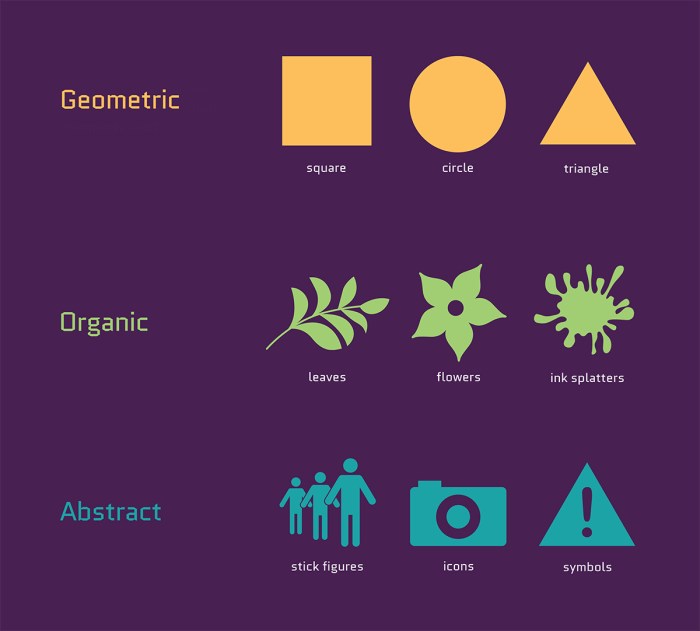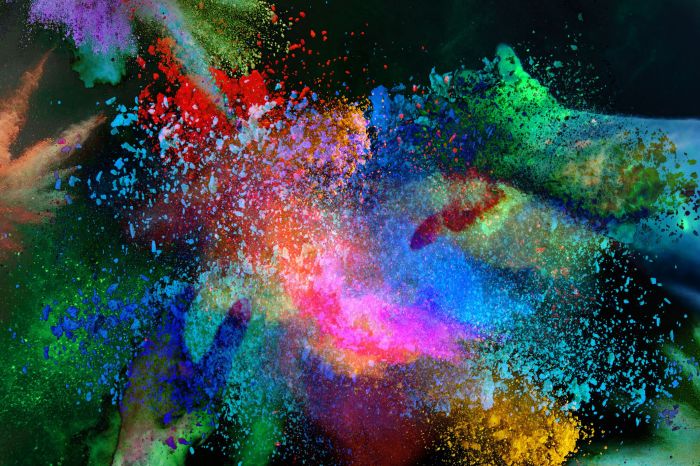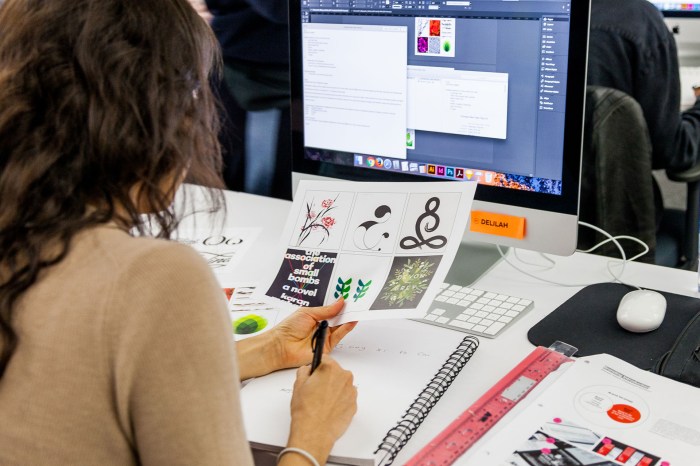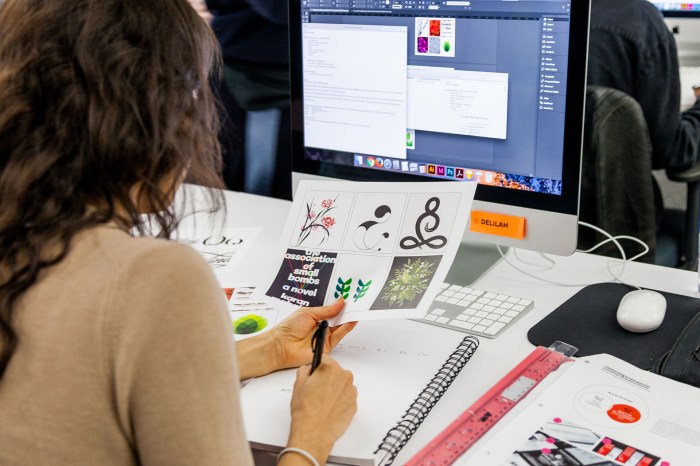In the realm of visual communication, pengertian seni grafis stands tall as a vibrant and multifaceted art form. From its humble beginnings to its contemporary manifestations, graphic art has played a pivotal role in shaping human expression and storytelling.
Delving into the intricacies of pengertian seni grafis, we embark on a journey that explores its historical evolution, diverse techniques, and profound impact on society. Along the way, we encounter influential figures and movements that have left an enduring legacy on this dynamic art form.
Define graphic art
Graphic art is a form of visual communication that uses visual elements such as lines, shapes, colors, and textures to convey a message. It encompasses a wide range of techniques and media, including drawing, painting, photography, digital art, and printmaking.
One of the key characteristics of graphic art is its focus on the visual impact of the image rather than its physical form. Graphic artists use visual elements to create a sense of depth, movement, and emotion, often without the use of words.
Characteristics of graphic art
- Visual impact:Graphic art is primarily concerned with the visual impact of the image, rather than its physical form.
- Use of visual elements:Graphic artists use visual elements such as lines, shapes, colors, and textures to create a sense of depth, movement, and emotion.
- Communication:Graphic art is a form of visual communication that can be used to convey a message or idea.
- Versatility:Graphic art can be used in a wide range of applications, including advertising, marketing, packaging, and web design.
Explore the history of graphic art

The history of graphic art spans thousands of years, with its origins in ancient cave paintings and petroglyphs. Over time, graphic art has evolved through various techniques, styles, and movements, shaping the visual landscape of human history.
Key Figures and Movements
Throughout history, numerous key figures and movements have played pivotal roles in shaping the development of graphic art. Notable individuals include:
- Albrecht Dürer(1471-1528): German Renaissance artist known for his detailed engravings and woodcuts.
- William Blake(1757-1827): English Romantic poet and artist who produced illuminated manuscripts and prints.
- Henri de Toulouse-Lautrec(1864-1901): French Post-Impressionist artist famous for his colorful lithographs and posters.
Significant movements in graphic art history include:
- The Renaissance(14th-16th centuries): A period of artistic revival and humanism that saw the development of engraving and woodcut techniques.
- The Romantic period(18th-19th centuries): A movement characterized by emotional expression and the use of imaginative and fantastical imagery.
- The Modernist movement(early 20th century): A period of experimentation and innovation that challenged traditional artistic conventions.
Classify the different types of graphic art
Graphic art encompasses a diverse range of techniques, styles, and purposes. To provide a comprehensive understanding, we categorize graphic art into distinct types based on their unique characteristics.
Traditional Graphic Art Techniques
Traditional graphic art techniques involve manual processes and specialized tools.
- Engraving:Involves carving designs into a metal plate, then using ink and pressure to transfer the image onto paper.
- Etching:Similar to engraving, but the design is created by etching into a metal plate using acid.
- Lithography:A process that uses a flat stone or metal plate with an image drawn in a greasy substance. The plate is then moistened, and ink is applied, which adheres to the greasy areas, creating the image.
- Woodcut:An image is carved into a wooden block, and ink is applied to the raised areas, which are then pressed onto paper.
Digital Graphic Art Techniques
Digital graphic art utilizes computer software and technology.
- Raster Graphics:Images are composed of pixels, which are small squares of color. This format is suitable for photographs and other images with continuous tones.
- Vector Graphics:Images are defined by mathematical equations, resulting in smooth lines and shapes. This format is ideal for logos, illustrations, and designs that require scalability.
- 3D Graphics:Creates three-dimensional images using computer software. This technique is used in animation, video games, and product design.
Graphic Art Styles
Graphic art styles encompass a wide range of artistic approaches.
- Realism:Depicts subjects as accurately as possible, with attention to detail and shading.
- Impressionism:Focuses on capturing the overall impression of a subject, using loose brushstrokes and vibrant colors.
- Abstract Expressionism:Expresses emotions and ideas through non-representational forms, often using bold colors and gestural marks.
- Pop Art:Incorporates elements of popular culture, such as advertising and comic books, into fine art.
Graphic Art Purposes
Graphic art serves a variety of purposes, including:
- Commercial Art:Used in advertising, marketing, and packaging to promote products and services.
- Fine Art:Created for aesthetic purposes, often exhibited in galleries and museums.
- Educational Art:Used in textbooks, educational materials, and infographics to convey information.
- Social Commentary Art:Explores social issues, raises awareness, and provokes thought.
Describe the elements and principles of graphic design
Graphic design involves a combination of fundamental elements and principles that contribute to the effectiveness and impact of visual communication. Understanding these elements and principles is essential for creating visually appealing and meaningful graphic art.
Elements of Graphic Design
The primary elements of graphic design include:
- Line:Lines define shapes, create movement, and convey emotions.
- Shape:Shapes create form, define space, and attract attention.
- Color:Color evokes emotions, establishes hierarchy, and conveys information.
- Texture:Texture adds depth, interest, and a sense of realism.
- Typography:Typography refers to the art of arranging text, including font choice, size, and spacing.
Principles of Graphic Design
The principles of graphic design guide the arrangement and organization of these elements to achieve a cohesive and visually appealing design. These principles include:
- Balance:Balance creates visual stability and harmony.
- Contrast:Contrast highlights differences between elements, creating visual interest and emphasis.
- Repetition:Repetition reinforces visual elements and creates a sense of unity.
- Proximity:Proximity groups related elements together, creating a visual hierarchy.
- Alignment:Alignment organizes elements to create a sense of order and cohesion.
By skillfully combining these elements and principles, graphic designers create visual communication that effectively conveys messages, evokes emotions, and engages audiences.
Discuss the tools and techniques used in graphic art
Graphic art creation involves a diverse array of tools and techniques, ranging from traditional mediums to advanced digital technologies.
Traditional Tools
- Pencils: Graphite pencils provide a range of values for sketching and drawing.
- Charcoal: Charcoal sticks and pencils create bold, expressive marks.
- Ink: India ink, watercolor ink, and other inks offer a wide spectrum of colors and textures.
- Brushes: Brushes made from various materials, such as bristles, nylon, and sable, are used for painting and drawing.
- Printmaking tools: Techniques like woodcut, linocut, and etching employ specialized tools to create prints.
Advantages of traditional tools include their tactile nature, allowing for direct manipulation of the artwork. However, they can be time-consuming and require specific skills.
Digital Tools
- Graphic design software: Programs like Adobe Photoshop, Illustrator, and InDesign provide a comprehensive suite of tools for digital art creation.
- Digital tablets: Pen tablets and graphics tablets enable precise drawing and painting on a digital canvas.
- 3D modeling software: Tools like Blender and Maya allow for the creation of three-dimensional models.
- Digital printing: Printers like inkjet and laser printers produce high-quality prints from digital files.
Digital tools offer advantages such as versatility, ease of editing, and accessibility. However, they can lack the tactile experience of traditional tools and require technical proficiency.
Analyze the role of graphic art in society
Graphic art plays a multifaceted role in society, serving as a potent tool for communication, information dissemination, and persuasion. It has a profound impact on culture, politics, and business, shaping perceptions, influencing opinions, and driving social change.
Graphic Art in Communication
Graphic art is a powerful means of visual communication, enabling the transmission of ideas and messages across diverse audiences. Through symbols, images, and typography, it conveys complex concepts in an accessible and engaging manner. From infographics that simplify data to posters that convey powerful messages, graphic art facilitates effective communication in various settings, including education, marketing, and public awareness campaigns.
Graphic Art in Information
Graphic art serves as an essential tool for presenting and disseminating information in a visually appealing and understandable way. It helps organize and present complex data in charts, graphs, and diagrams, making it easier for audiences to grasp and retain information.
By leveraging visual elements, graphic art enhances the comprehension and recall of key messages, making it a valuable asset in fields such as journalism, scientific research, and education.
Graphic Art in Persuasion
Graphic art is a persuasive force that can influence opinions and drive action. Through carefully crafted visuals and compelling messaging, it can persuade audiences to adopt specific viewpoints or engage in desired behaviors. From political campaigns that sway voters to advertisements that entice consumers, graphic art plays a significant role in shaping public opinion and influencing purchasing decisions.
Impact of Graphic Art on Culture
Graphic art has a profound impact on culture, reflecting and shaping societal values, beliefs, and aesthetics. It serves as a visual record of historical events, cultural traditions, and artistic movements. From traditional paintings and sculptures to contemporary digital art, graphic art contributes to the collective cultural heritage and influences the development of new artistic styles and expressions.
Impact of Graphic Art on Politics
Graphic art is closely intertwined with politics, serving as a powerful tool for political expression and persuasion. Political posters, caricatures, and other forms of graphic art have been used throughout history to convey political messages, influence public opinion, and mobilize support for specific causes or candidates.
Graphic art continues to play a significant role in political campaigns and movements, shaping political discourse and influencing electoral outcomes.
Impact of Graphic Art on Business
Graphic art is an indispensable asset in the business world, helping companies establish their brand identity, promote their products and services, and engage with customers. Logos, packaging, and marketing materials all leverage graphic art to create a visually appealing and memorable brand experience.
Effective graphic design can differentiate a business from its competitors, enhance customer loyalty, and drive sales.
Examine the career opportunities in graphic art: Pengertian Seni Grafis

The graphic art industry offers a wide range of career opportunities for individuals with creativity, technical skills, and a passion for visual communication. These roles encompass various aspects of graphic design, from conceptualization to execution and management.
To succeed in these roles, individuals typically require a combination of formal education, specialized training, and a strong portfolio showcasing their skills and experience.
Job Roles in Graphic Art
- Graphic Designer:Responsible for creating visual concepts, developing designs, and producing graphics for various media, including print, digital, and social media.
- Art Director:Oversees the creative vision and execution of graphic design projects, leading teams of designers and providing direction on aesthetic and conceptual matters.
- Web Designer:Specializes in designing and developing websites, ensuring user-friendly navigation, visual appeal, and functionality across multiple devices.
- UI/UX Designer:Focuses on creating intuitive and engaging user interfaces (UI) and user experiences (UX) for websites, apps, and software products.
- Motion Graphics Designer:Creates animated graphics, videos, and interactive content for various platforms, including websites, social media, and television.
- Production Artist:Prepares and finalizes graphic designs for production, ensuring adherence to technical specifications and quality standards.
- Creative Director:Leads creative teams, develops creative strategies, and oversees the overall direction and execution of graphic art projects.
Showcase notable graphic artists and their work
Graphic art has a rich history with many notable artists who have made significant contributions to the field. These artists have developed unique styles and techniques, pushing the boundaries of graphic art and inspiring future generations.
Albrecht Dürer
Albrecht Dürer was a German artist known for his detailed and expressive woodcuts and engravings. His work often depicted religious themes and mythological scenes, and he was a master of chiaroscuro, using light and shadow to create dramatic effects. One of his most famous works is “Knight, Death, and the Devil” (1513), which depicts a knight riding through a dark forest, accompanied by Death and the Devil.
William Blake
William Blake was an English artist and poet known for his visionary and mystical works. He used a variety of techniques, including engraving, etching, and watercolor, to create images that were both beautiful and thought-provoking. His work often explored themes of religion, mythology, and the human condition.
One of his most famous works is “The Tyger” (1794), which depicts a powerful and enigmatic tiger.
Understanding graphic art involves studying various techniques used to create visual representations. These techniques can be further explored in the context of agriculture, as exemplified in the article Cara Mengolah Hasil Panen: Teknik Persiapan dan Metode . This article provides insights into the processes of preparing and handling harvested crops, demonstrating the practical application of techniques similar to those employed in graphic art.
M.C. Escher
M.C. Escher was a Dutch artist known for his complex and mind-bending optical illusions. He used mathematical principles to create images that appear to be impossible, such as staircases that lead nowhere and impossible figures. His work has been used in a variety of applications, including architecture, design, and mathematics.
One of his most famous works is “Relativity” (1953), which depicts a world where gravity appears to be suspended.
Andy Warhol
Andy Warhol was an American artist known for his pop art creations. He used mass-produced images and objects to create works that commented on consumerism and celebrity culture. His work often featured iconic figures such as Marilyn Monroe and Elvis Presley.
One of his most famous works is “Campbell’s Soup Cans” (1962), which depicts a series of soup cans in different colors.
Create a gallery of graphic art
A gallery of graphic art is a collection of artworks that showcases the diverse range of techniques and styles used in the field. It provides a platform for artists to display their creativity and for viewers to appreciate the beauty and significance of graphic art.
Seni grafis, a form of art that encompasses printmaking techniques, involves the creation of images on paper or other surfaces. To delve deeper into the spiritual realm, consider exploring the comprehensive guide on Cara Berzikir Sesuai Ketentuan: Panduan Lengkap . Returning to the topic of seni grafis, it showcases a diverse range of methods, from traditional etching to modern digital printing.
High-quality images and brief descriptions
A visually appealing gallery should include high-quality images of each artwork, accompanied by brief descriptions that provide insights into the artist’s inspiration, technique, and the significance of the piece. These descriptions should be informative and engaging, providing viewers with a deeper understanding of the artwork and the artist’s creative process.
Design an interactive quiz on graphic art
To assess your understanding of graphic art, an interactive quiz has been designed. This quiz will delve into various aspects of graphic art, including its history, techniques, and applications.
The quiz incorporates multiple-choice questions to test your knowledge of key concepts, short answer questions to evaluate your comprehension, and image-based questions to assess your visual literacy.
Quiz Content, Pengertian seni grafis
The quiz encompasses the following areas:
- History of graphic art
- Types of graphic art
- Elements and principles of graphic design
- Tools and techniques used in graphic art
- Applications of graphic art in society
Final Review

In conclusion, pengertian seni grafis is a testament to the power of visual communication. Its ability to transcend boundaries, convey messages, and evoke emotions makes it an indispensable tool in the hands of artists, designers, and communicators alike.
As we continue to witness the evolution of graphic art in the digital age, its potential for innovation and impact remains boundless. Pengertian seni grafis will undoubtedly continue to captivate and inspire generations to come.
Detailed FAQs
What is the main purpose of pengertian seni grafis?
The primary purpose of pengertian seni grafis is to communicate visual messages effectively, whether for artistic expression, information dissemination, or commercial promotion.
How has technology influenced pengertian seni grafis?
Technological advancements have revolutionized pengertian seni grafis, introducing digital tools and techniques that have expanded its possibilities. From digital printing to computer-aided design, technology has made graphic art more accessible, versatile, and impactful.
What are some common techniques used in pengertian seni grafis?
Traditional techniques include drawing, painting, printmaking, and typography, while digital techniques encompass photo manipulation, vector graphics, and 3D modeling. The choice of technique depends on the artist’s style, purpose, and desired aesthetic.

